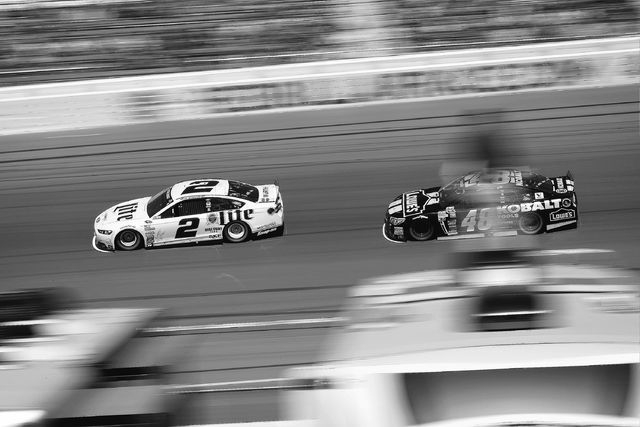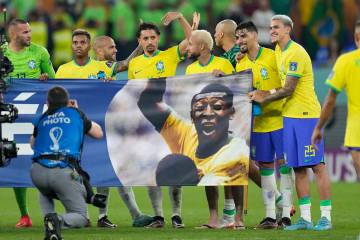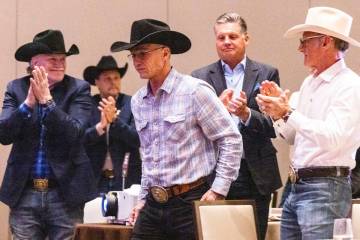As NASCAR wants, this Cup race had its Game 7 moment
It was about halfway through the Kobalt 400 on Sunday afternoon when the Performance Racing Network announcer’s voice crackled over the speakers in the media center. He reported that he was back at Las Vegas Motor Speedway, that the race was being dominated by Kevin Harvick, that only 16 cars were on the lead lap.
Maybe it was just me, but he sounded disappointed.
I’ll bet he wasn’t disappointed at the end.
At the end, Dale Earnhardt Jr. ran out of Sunoco Racing Fuel, as the announcers on TV like to say. Brad Keselowski passed him and won the race.
It was exciting.
At least at the end.
This was supposed to be the race where NASCAR would begin to learn if its constant tinkering with the rules — changing the aerodynamic package on the cars and the ride heights and whatnot — would make races more interesting on the 1.5-mile ovals, of which Las Vegas is one.
Those weren’t the rule changes that made the Kobalt 400 more interesting. It was the one about expanding the NASCAR playoffs to 16 drivers, and virtually guaranteeing every race winner a spot in the Chase for the Sprint Cup at season’s end.
With Earnhardt Jr. having won the season-opening Daytona 500, his playoff spot is secure. They should just put a little “x” next to his name, like in the baseball standings when the Yankees win the American League East and clinch a playoff spot.
So The World’s Most Popular Driver — not to be confused with The Most Interesting Man in the World from the beer commercials, who gave the command to start engines — was able to gamble on fuel mileage at the end.
If Earnhardt Jr. doesn’t gamble on fuel mileage, he pits on schedule with the other cars when the last of four bogus yellow flags for debris (or fluid) came out, and then he finishes eighth or ninth, and then Keselowski wins by like five or six seconds.
One thing led to another, like in those satellite TV commercials. Except nobody got slammed by a lowland gorilla. (There were no crashes.)
If Keselowski had won by five or six seconds, people in the press or in the grandstands would have said it was pretty much follow the leader, like it sometimes is on the 1.5-mile ovals. And then NASCAR and the guys who build 1.5-mile racetracks would have gotten slammed by lowland gorillas, or at least by people who know how to use Twitter.
Was it more interesting for the drivers?
“Leading the race the last 50 laps was a lot better than running eighth the last 50 laps,” Earnhardt Jr. said. “I was interested.”
So, too, it appeared, were the fans in the packed grandstands at the start-finish line (the stands in the turns weren’t nearly as packed). Most were on their feet when Earnhardt Jr. ran out of Sunoco Racing fuel.
None tried to commit suicide by climbing the catch-fence and leaping onto the track, which might have been a bigger upset than Paul Menard finishing third.
But at the end of the day, this was a race decided in the pit lane, with computers and calculators and a rabbit’s foot, because Earnhardt Jr. said the crew knew he’d have to be lucky to make it to the end.
It was not decided on the racetrack with a daring last-lap pass.
The winning car did not skid across the finish line on its roof. The new aero rules and ride heights seemed to have a negligible effect.
Sunday’s race at LVMS, to the untrained eye, looked a lot like the other 16 Sprint Cup races at LVMS.
Is that a bad thing?
A lot of people who write about stock cars and watch them race around in circles on TV want every race to be exciting, or at least exciting at the end. Obviously, these people have never written about an 8-1 baseball game, or watched the Patriots beat the Lions 42-7.
Not every ballgame is exciting. Not every football game is decided in sudden death. Yet NASCAR people think every race should end with the equivalent of Joe Carter taking Mitch Williams deep and jumping up and down as he trots around the bases.
Game 7 moment. That’s what NASCAR calls it. That’s why it keeps tinkering with the rules. It wants more Game 7 moments.
A Game 3 moment, or a Game 4 moment, or a Tuesday moment in Cleveland on bobblehead night with the Royals in town isn’t good enough anymore. It has to be a Game 7 moment.
This is why today’s NASCAR fans are spoiled.
When I first started watching stock-car races on TV, they were on “Wide World of Sports” usually two weeks after they happened. You had to sit through Acapulco cliff diving first.
In 1973, which is when I remember first watching stock-car racing on TV, there were 28 races, and in 15 of them only one car finished on the lead lap.
David Pearson won the Rebel 500 that year over Benny Parsons by 13 laps.
Stock-car racing managed to survive without a bunch of Game 7 moments.
After Dale Earnhardt Jr. ran out of fuel, and Brad Keselowski passed him, and Junior’s fans considered climbing the catch-fence and leaping onto the track in abject despair, the PRN announcer’s voice crackled over the media center speakers for the last time.
“This is gonna be one they remember for a long time, guys,” he said.
Las Vegas Review-Journal sports columnist Ron Kantowski can be reached at rkantowski@reviewjournal.com or 702-383-0352. Follow him on Twitter: @ronkantowski.







